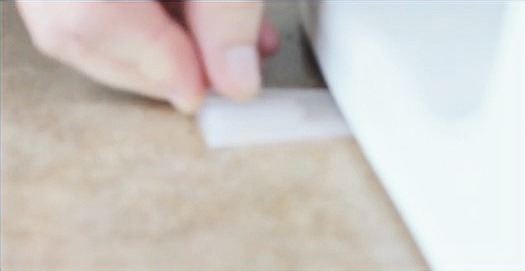Last Updated on June 14, 2024 by John Coleman
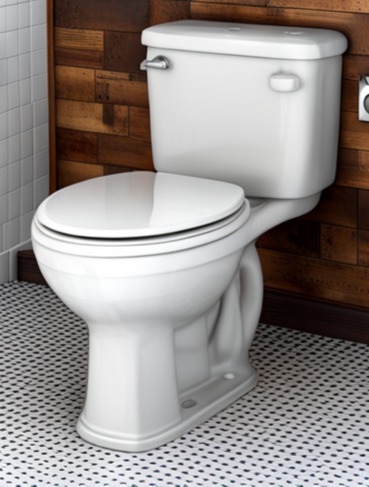
The flush mechanism in your toilet is a marvel of modern living that we often take for granted. It gives us a quick and effective way to dispose of waste, keeping our homes clean and hygienic. But, if you’ve ever had a weak, slow, or non-functioning flush, you know it can cause more problems than just a minor inconvenience. In this guide, we’ll explore the main reasons your flush might be underperforming and offer you practical tips to get your toilet flushing like new again.
What is Considered a Weak or Slow Flush?
Before we dive into the causes and solutions, it’s essential to understand what constitutes a weak or slow flush. A standard flush in most toilets should be powerful enough to move waste efficiently through the plumbing system and out of your home. If you notice that the water is not draining correctly or that you need to flush multiple times for everything to go down, then your toilet has a weak or slow flush. This issue can be frustrating, and it’s crucial to address it promptly to avoid further complications.
Causes, Diagnosing, and DIY Fixes for a Weak or Slow Flushing Toilet
A weak or slow flush can spell disaster for your daily routine. The toilet may not clear the bowl completely, causing unsanitary conditions and leaving you with a perpetually messy situation. Understanding why your flush has lost its oomph is the first step to solving the issue.
Clog in the Drain Line or Trap
A common cause of reduced flushing power, a stubborn clog can impede the flow of water through the toilet’s waste outlet, effectively choking your flush to a halt.
How to Check:
If the bowl fills up but doesn’t drain, or if you hear gurgling sounds when flushing, there may be a clog in your drain line.
How to Fix:
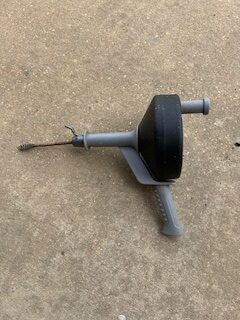
- Use a plunger to try and clear out any obstructions.
- If plunging doesn’t work, try using a toilet auger (also known as a “snake”) to reach deeper into the drain and remove any blockages.
- If these methods don’t work, you may need to call a professional plumber for assistance.
If you purchase through links on this site, we may earn a small commission. See our affiliate disclosure.
Damaged or Worn Out Flapper
The flapper is responsible for holding water in the tank until it’s flushed, then releasing it quickly and effectively when the handle is pushed down.
How to Check:
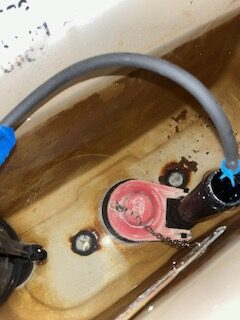
- Take the lid off the toilet tank and inspect the flapper for any visible damage or wear.
- If your toilet is constantly running, it may be due to a worn-out flapper that needs to be replaced.
How to Fix:
- Turn off the water supply to the toilet and flush it, removing as much water from the tank as possible.
- Remove the old flapper and replace it with a new one, making sure to properly align it in the designated spot. Be sure to look at your old flapper and note it’s size, shape, and how it attaches to the overflow tube. This will allow you to purchase the correct replacement.
- Turn the water supply back on and test your flush to ensure that it is working effectively.
Faulty Fill Valve
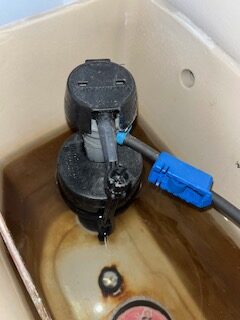
The fill valve is responsible for filling the tank with water after each flush, allowing for proper flushing power.
How to Check:
- If you hear a hissing sound coming from your toilet tank or notice that the water level is constantly fluctuating, there may be an issue with the fill valve.
- You can also try flushing the toilet and observing if the water fills up quickly or slowly.
How to Fix:
- Turn off the water supply to the toilet and flush it, removing any excess water from the tank.
- Remove the old fill valve and replace it with a new one, making sure to properly align and tighten all connections.
- Turn the water supply back on and test your flush to ensure that it is working effectively.
Inadequate Tank Water Levels
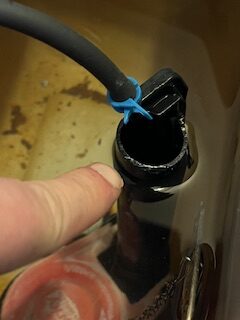
The water inside your toilet’s tank needs to reach a certain level for the flush to initiate and sustain. If the tank isn’t filling to this level, your flush will be compromised.
How to Check:
- Remove the tank lid and visually inspect the water level. It should be about 1 inch below the top of the overflow tube.
- If it is significantly lower, there may be an issue with your fill valve or a blockage in your supply line
How to Fix:
- First, check if your fill valve needs to be adjusted or replaced as mentioned in the previous section.
- If that doesn’t solve the issue, check for any obstructions in your supply line and clear them if necessary.
- You can also try adjusting the water level in the tank by using the fill valve adjustment screw. Turn it clockwise to decrease the water level or counterclockwise to increase it.
- Test your flush after each adjustment until the water level is at the desired height.
Partially Closed Shut-Off Valve

The shut-off valve is the mechanism that controls the flow of water into your toilet’s tank. If it’s not completely open, it can limit the amount of water entering the tank, which in turn affects the flush.
How to Check:
- Locate the shut-off valve usually located behind or next to the toilet.
- Make sure it is fully open by turning the handle counterclockwise.
How to Fix:
- If the valve is stuck, try loosening it with a wrench and then opening it fully.
- In some cases, the valve may be faulty and will need to be replaced.
- Consult a plumber if you are unsure how to replace the valve yourself.
Build-Up in the Rim Feed and Jet Holes
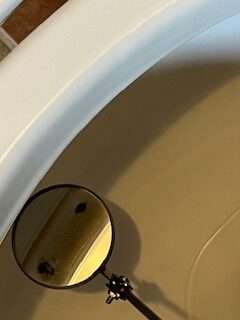
Over time, minerals and debris can build up in the rim feed and jet holes under the toilet bowl’s rim, affecting the flow of water during a flush. This can result in a weak or incomplete flush.
How to Check:
- Use a mirror to check for any build-up in the rim feed holes under the toilet bowl’s rim. For this, I like to use a small telescopic mirror but any handheld mirror will work.
How to Fix:
- Use a toilet brush or small scrub brush to clean the rim feed and jet holes. You may even need to use a piece of small wire to poke into each jet hole.
- You can also pour white vinegar into the overflow tube and let it sit for about 15 minutes. Some may suggest using bleach but I prefer use vinegar to avoid breathing in harsh chemical fumes.
- Repeat this cleaning process every few months to prevent future build-up.
Sewer Line Obstruction
If none of the above issues seem to be causing your weak flush, the problem may be with your sewer line. A blockage in the sewer line can prevent proper water flow and cause a weak or incomplete flush.
How to Check:
- If you notice other plumbing fixtures in your home draining slowly or making gurgling noises, it could indicate a blockage in the sewer line.
How to Fix:
- In this case, it’s best to call a professional plumber who can use specialized tools to clear out any blockages in your sewer line.
- Regular maintenance of your sewer line, such as using enzyme-based cleaners or scheduling professional cleanings, can also help prevent future obstructions.
- It’s important to address any sewer line issues promptly to avoid potential backups and costly repairs in the future.
Aging Components
As with any mechanical system, the components of a toilet can wear down over time and become less effective. This can result in a weaker flush as the parts struggle to perform their intended function.
If you have an older toilet that is consistently giving weak flushes even after replacing worn parts and DIY fixes, it may be time to consider upgrading to a newer model with more efficient and powerful flushing mechanisms.
When Professional Plumbing Help is Required
There are instances when a weak flush is a sign of more severe issues. If you notice any of these red flags, it’s time to call the pros:
Continuously Weak Flush After DIY Fixes
If your attempts at improving your flush don’t yield any results, you could be dealing with a problem that requires a professional’s eye.
Multiple Clogs in Different Locations
Recurrent clogs throughout your house can indicate a problem with your main drain line, which is not a DIY fix.
Water Leaks or Signs of Water Damage
Leaks around your toilet or in the vicinity can suggest a problem with the toilet seal, wax ring, or even the water supply line, all of which require a professional approach.
Unusual Sounds or Odors
Gurgling sounds, unpleasant odors, or even gas smells could indicate a problem with your sewage system that requires immediate attention.
Presence of Sewage Backup
If a sewage backup occurs in your toilet, sinks, or bathtub, it’s a definite sign to call in a professional plumber right away. Sewage backups can be hazardous to your health and require immediate and professional assistance for proper and safe removal.
Additional Tips for Proper Toilet Maintenance
While dealing with weak flushes, it’s essential to remember to maintain your toilet regularly. Here are some additional tips for keeping your toilet in top shape:
Regularly clean the inside of your toilet bowl and tank to prevent the buildup of mineral deposits or debris that could obstruct flushing mechanisms.
Avoid using excessive amounts of toilet paper or flushing foreign objects down the toilet to prevent clogs.
If you notice any leaks or signs of water damage, address them immediately to prevent further damage and potential health hazards.
If you purchase through links on this site, we may earn a small commission. See our affiliate disclosure.
Preventing Weak Flushes in the Future
Don’t wait for your toilet to lose its flush capability – be proactive. Here are some tips to prevent future issues:
Practice Good Toilet Habits
Only flush toilet paper and waste designed for toilets. Avoid flushing down items that can cause clogs, like paper towels or feminine hygiene products.
Regular Maintenance
Schedule periodic checkups with your toilet – inspect the tank components, water levels, and flush performance. A few preventative tweaks can avoid future headaches.
Stay Informed
The more you know about your plumbing system, the better you can maintain and deal with issues as they arise. Knowledge is your best ally in keeping your toilet’s flush at peak performance.
The Full Flush Restoration
Fixing a weak flush might seem like a small victory, but it’s part of a bigger win – maintaining the comfort and functionality of your home. By understanding the reasons behind your toilet’s weak flush, diagnosing the specific issues, and taking the appropriate corrective measures, you ensure that this essential appliance works reliably.
Remember, your toilet is as good as the care you put into it. Take these lessons to heart, and never underestimate the importance of a good flush – or the satisfaction of a well-performing plumber’s warranty.
Frequently Asked Questions
Why is my toilet slow but not clogged?
A weak flush can be caused by a variety of reasons, including low water levels, clogged pipes or jets, faulty tank components, and mineral buildup.
What is the strongest flushing toilet?
There are several highly-rated toilets known for their powerful flush, including the TOTO Drake, American Standard Champion 4, and Kohler Cimarron. However, the strength of a toilet’s flush also depends on proper maintenance and usage habits.
Can I convert my toilet to a power flush system?
If you have a low-flow toilet, it cannot be converted to a high-flow or pressure-assisted toilet. It would be best to contact a plumber who can assess your current plumbing setup and make recommendations.
What toilet brands are known to flush better?
Aside from the aforementioned TOTO, American Standard, and Kohler, other reputable toilet brands known for their strong flush include Gerber, Mansfield, and Niagara. It’s always best to research and read reviews before making a purchase decision.
Are pressure-assist toilets worth it?
Pressure-assisted toilets use pressurized air to aid in flushing and can be more powerful than traditional gravity-fed toilets. They can also be louder and more expensive, but they may be worth it for those looking for a strong flush, reduced clogging, and a water-efficient option.
How often should I replace the tank components of my toilet?
It is recommended to replace the tank components, such as the fill valve and flapper, every 5-7 years to ensure proper functioning and avoid potential issues like running or leaking toilets. However, regular maintenance can help extend the lifespan of these components.
Disclaimer: This post is for informational purposes only. If you are uncertain about any DIY plumbing task, it’s best to contact a professional plumber to ensure your safety and prevent potential damage to your property.






